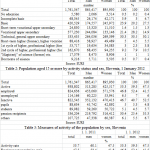Saopštenje statističkog zavoda Republike Slovenije.
Januara 2012. godine 30% slovenačkog stanovništva starijeg od 15 godine je bilo penzionisano.
Fewer persons in employment than a year before
According to the Statistical Office of Slovenia, the number of active persons (i.e. employed and unemployed) decreased by about 5,800 in 2011 and reached 938,802. On 1 January 2012 employed persons represented just under 88% of all active persons
(about half a percentage point less than a year earlier).
In 2011 the number of pension recipients among the population of Slovenia increased by about 34,000 (to 536,204). Nearly two thirds (65%) of all inactive population aged 15 or more (i.e. retired persons, pupils and students, and other inactive), were retired (62% in 2011). The number of pupils and students decreased by about 4,000. The number of other inactive population decreased (by 22,000) mostly due to the increase in the number of pension recipients.
Among Slovenian citizens aged 15 or more, 46% were employed. Among foreign citizens of the same age, more were employed: 64%. There was a large gap between men and women regarding employment/population ratio among foreigners: 76% of the men and only 35% of the women were employed. This gap was smaller among citizens of Slovenia: 51% of the men and 42% of the women were employed. The gap was even smaller among Slovenian citizens aged 25–49, where 82% of the men and 79% of
the women were employed.
Better educated
The share of population with tertiary education in Slovenia increased by 1.3 percentage points in 2011. The increase was more marked among women (by 1.6 percentage points, 1.0 percentage point among men). On 1 January 2012 Slovenia had 331,398
residents with tertiary education.
The number of population with basic or lower education decreased, which is the result of young people continuing their education and also of low education among those who died in 2011. Among the population aged 65 or over, there were 48% with
basic or lower education on 1 January 2012, while among the population aged 25–49, there were 14% with that level of education. In total, there were 494,454 residents aged 15 or more with basic or lower education.
Foreign citizens who represented 4.4% of total population of Slovenia aged 15 or more had on average lower education than Slovenian citizens, although higher than one year earlier. The share of the population with tertiary education among foreign citizens increased from 5.9% to 6.5%, and the share of those with upper secondary education from 50.2% to 53.6%. Accordingly, the share of those with basic or lower education decreased (to 40.0%).
On 1 January 2012, 28% of citizens of Slovenia had basic or lower education, 53% had upper secondary education, and 19% had tertiary education, which is very similar to the education structure of this population group from one year earlier.
Better education among the employed, retired women less educated than retired men
Among the employed population, 29% had tertiary education. Among the unemployed population, this share was a half lower: 14%. The share of those with upper secondary education is similar in both groups, a little under 60%. Accordingly, the share of those with basic or lower education is higher among the unemployed: 26% as opposed to 13% among the employed.
More than a third of pension recipients had basic education. Due to a specific age-sex structure of this group (more women live to old age), there were more women with basic or lower education (54%) than men (fewer than 30%). The smallest gap between sexes was recorded among retired persons with tertiary education, but they were quite few (about 10%) and were mostly less than 70 years old.
 Макроекономија Економске анализе, Србија, окружење, и међународна економија
Макроекономија Економске анализе, Србија, окружење, и међународна економија
